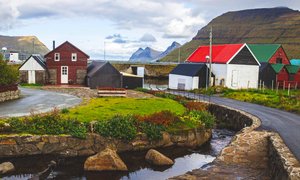Shetlends?s Oil Experience
Hans J. Marter
Shetland is ready for the Faroese oil industry to take off and is confident that both island groups will benefit hugely once oil is discovered in the Faroese sector.
Already speculations are mounting to what extent the islands? massive oil terminal at Sullom Voe will be able to handle oil extracted from Faroese wells. A simple look at a map of the North East Atlantic reveals how close the infrastructure, which is being developed in the North and West of Shetland, is located to the prospective oil province on the other site of the border between the UK and Faroe.
Former Sullom Voe Oil Terminal manager Gordon Grant plays ? for obvious reasons ? his cards very close to his chest when it comes to the prospects of handling future oil from the Faroese sector. Fact is that the terminal has received a major £50 million overhaul this summer. Talking about the future, Mr Grant said earlier this year:
»We have the confidence that we can deliver the services required by the East and the West of Shetland oil fields. It is investment today for the ongoing business tomorrow.«
Others are more open about their aspirations and hopes. The chief executive of the Lerwick Port Authority, Allan Wishart says the whole region is already benefiting from increased activity.
»The harbour has recently been very, very busy with oil related ships. Our income this year is well up, and much of that is thanks to oil-related offshore activity.«
»There is more emphasis now on these areas, especially with the turmoil in the Middle East. The Shetland and the Faroese area is becoming more important«
Morgan Goodlad, chief executive of the Shetland Islands Council, is at present heavily involved in negotiating a number of closer business links between Shetland and Faroe. These include mainly transport improvements, but there is no reason why this should not include the transportation of oil and gas as well.
He sees a good chance that some of the oil may come Shetland?s way, particularly if a »critical mass of discoveries« can not been made to justify the construction of a similar oil terminal in Faroe.
»If the Faroes discoveries are not big enough for a terminal in Faroe, then we are hopeful, that it should be viable to connect into Sullom Voe Oil Terminal.«
However, he acknowledges that it is very early days yet to speculate on this possibility since so far, only three wells have been drilled in the Faroese sector, and none was successful. Also, it has been made clear by the Faroese authorities that it was their intention to land Faroese oil in Faroe in an attempt to gain the full economic benefits.
Mr Goodlad adds that Sullom Voe and a fictive Faroese terminal would have to compete with the cheaper but environmentally undesirable option of offshore loading, having the potential of by-passing both island groups.
Only in October, Sullom Voe Oil Terminal received a major boost, when BP announced in Aberdeen that the company and its partners in the massive Clair oil field ? 75 kilometres to the northwest of Shetland - had reached agreement and intended to go ahead with Phase 1 of the field?s development, which will see the recovery of up to the first 250 million barrels of an overall resource of approximately 1.75 billion barrels from 2004 onwards.
This not only will top up the terminal?s daily throughput by another 60,000 barrels, but ? more importantly ? will see the construction of a pipeline between Sullom Voe and the Clair field capable of handling up to 530,000 barrels a day.
Easy to see what Mr Goodlad?s thoughts are, when he comments: »We hope the Clair development will mean continuation of the Sullom Voe Oil Terminal much beyond what we have originally envisaged. It is the first piece of fixed infrastructure going out west. There is a lot of exploration going on to the West of Shetland and to the East of Faroe, and therefore we regard this as very significant development.«
This statement, although not 100% accurate1, highlights the confidence Shetlanders have gained in dealing with the oil industry.
To arrive where the islands are today, has taken just over 25 years, a period that can be described as an unprecedented (black) gold rush, that catapulted a rural island community from the 19th century into the 21st century within one generation.
The early days
Oil exploration started around Shetland in the late sixties. When, in 1972, the first commercial field was discovered, Shetlanders were not impressed. Moreover, with a ?booming economy? fuelled by the islands? traditional industries of fishing and fish processing, knitwear and agriculture, islanders saw no reason why they should respond to the oil industry?s courting.
It was, in fact, the desolate state of the economy of the UK and the central government?s hunger for oil revenues that put Shetland in a comparatively strong negotiating position with the oil industry. After all, the oil multies wanted something from the island community ? namely a landfall for oil from the huge fields in the East Shetland Basin ? rather than the islanders longing for the influx of a completely new world. In fact, considerable concern was voiced as regards to the impact the advent of the oil industry would have on the islands? pristine environment, the traditional economy, and the specific Shetland way of life, namely the islands? unique identity and its heritage.
It was against this background that the UK Labour government was willing to hand down far reaching powers to the local government of the islands, which enabled local councillors to negotiate on a more equal level with the oil bosses. Known as the Zetland County Council Act 1974, the devolution of powers, including the jurisdiction of the inshore waters, gave the Shetland Islands Council a degree of autonomy that - in UK terms ? is only outreached by that of the Channel Islands and the Isle of Man.
Inevitably, events between 1972 (first commercial field) and 1978 (first oil ashore to the Sullom Voe Oil Terminal) were stormy as can be imagined when thousands of male construction workers had to temporarily be housed in a society largely untouched by influences from the outside world.
Tough bargaining on the side of the oil industry in uncountable formal and informal meetings between the supposedly David and the obvious Goliath created a lot of bitter feelings. However, in retrospective, Shetland and its way of life succeeded. The community has probably won the best deal possible and certainly, the best deal any small community has ever struck with the almighty oil industry.
Summarised, the content of this deal is as follows:
? all major activity was focussed in a single area at Sullom Voe, rather than spread over the whole islands, as it was the initial intention of the many oil companies involved
? Shetland Islands Council (SIC) owns and operates the port of Sullom Voe, while the Terminal is operated by BP Amoco on behalf of 30 oil company partners,
? An annual rent is paid to Shetland by the oil industry for the land on which the oil terminal is situated,
? A Shetland Islands Council company, namely Shetland Towage, provides all tug services in the harbour of Sullom Voe,
? A tough environmental regime had been put in place at the terminal, which made Sullom Voe not only Europe?s biggest but also Europe?s cleanest oil terminal,
? A specified amount of money is paid to Shetland Islands Council per barrel landed onshore at Sullom Voe. This agreement has been re-negotiated in 2000 with much reduced payments to the SIC in the light of declining North Sea oil expectations. However, due to improve oil recovery techniques and the development of oil fields to the West of Shetland, the presence of the terminal in Shetland has been secured for at least another 20 years.
Simplifying the complex structure of payments - and their reinvestment - made by the oil industry to Shetland Islands Council, Shetland has today (November 2001) investments worth around £700 million (equivalent to DK8.400 million), which are hold in four different funds, namely the:
? Harbour Fund; used for the development of Shetland?s ports and harbours,
? Capital Fund; used for investments in capital infrastructure, such as schools, roads, ferries etc,
? Reserve Fund; used of financing projects of general purposes like colleges, research and development, marketing etc,
? Charitable Trust; used for benefits to Shetland and its inhabitants, mainly in leisure and welfare purposes.
Benefits for the community
30 years after first oil was discovered in the Northern North Sea, Shetland is the envy of every local authority in Scotland and beyond. With an unemployment rate close to 1%, the islands? economy is continuously on the verge of overheating. The islands? authority with its many financial instruments has become the major player in the economy, stimulating growth, encouraging diversification and kick-starting new ventures.
Funded through the interests from investments on the international financial markets, Shetland Islands Council Charitable Trust pays for amenities other local authorities in the UK can?t afford, like
? a network of welfare centres, which are effectively old folk homes, built in Shetland?s more remote areas to allow vulnerable people to stay in the community;
? a network of leisure centres and swimming pools, which makes Shetland the place with the highest density of such facilities in the world;
? funding for numerous voluntary organisation covering every conceivable aspect of voluntary work,
? funding for organisations like Shetland Arts Trust, which actively promotes the arts in the islands and supports artists coming to Shetland as well as local artists travelling outwith Shetland,
? funding Shetland Amenity Trust, an organisation that restores old buildings, employs the county?s archaeologist and is engaged in the reforestration of the bleak bog covered hills.
Surprisingly, the oil industry is far from being the dominating feature despite its massive influence on life in Shetland. Apart from the visible impact of oil supply and other service vessels in Lerwick Harbour and the amount of Heavy Goods Vehicle traffic on the isles, visitors to Shetland may well spend days in the isles without ever getting close to the oil terminal. The centre of activity is hidden away 30 miles north from Lerwick, the busy capital of Shetland.
The side effects
With all these good news, one can justifiably ask whether Shetland ? within its limits of its devolved power ? has turned into a mini-welfare state, almost into a sort of ideal-world-socialism? Far from it!
Wealth is visible in the amount of new houses being built, in the size and the age of cars cruising the highway-like road network, and is expressed in the general upbeat and enterprising attitude of a successful community.
However, there are also plenty of signs that the community struggles to cope with the speed changes have been brought to life in Shetland:
? the almighty presence of the Shetland Islands Council has created a dependency culture among the islands? citizens that clearly can be described as unhealthy,
? the other side of that coin is a society dominated by the SIC whose elected members not only run the statutory services of a Scottish local authority, but also manages the huge financial resources of the islands and are regularly caught up in a mess of conflicting interests,
? retail prices and prices for services are considerably higher than what they are on the Scottish mainland,
? Shetland has a drug and alcohol abuse problem, evidence of a society where the almost unlimited access to wealth is turning against its citizens,
? Knowledge of ?the old ways? is increasingly lost particular among the younger generation.
In addition, economists warn that Shetland?s economy continues to have a fractured base. The deputy chief executive of the development agency Shetland Enterprise, Dr Ann Black said: »Shetland has and continues to have a fragile economic base: that of agriculture, fishing, knitwear and the tourism sector.« Worryingly, all these industries are in crisis.













